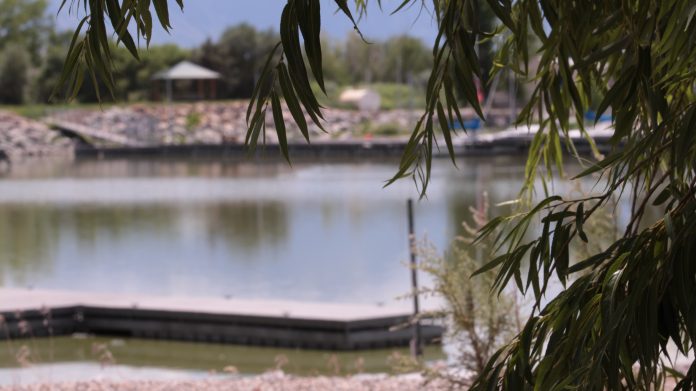PROVO, Utah, June 30, 2017 (Gephardt Daily) — A blue-green algae bloom discovered in Utah Lake’s Provo Bay appears to be spreading north, officials said Friday.
If the bloom continues to spread northward, it may reach the Jordan River in coming days, said a news release from the Utah Department of Environmental Quality. Water quality tests outside Provo Bay are pending to determine the risk to public health.
In the meantime, officials encourage people to enjoy Utah Lake, but avoid swimming in dark-green water or areas of heavy scum.
Utah County Health Department (UCHD) and Utah State Parks have posted warning signs along Provo Bay Marina, which is the closest access point to where the algal bloom was identified via satellite imagery in Provo Bay, roughly a mile southeast of the marina. The warnings caution people from recreating in Provo Bay due to the potential health risk.
“We want people to enjoy Utah Lake during this holiday season, but we want them to be mindful of the presence of algae that have the potential to produce toxins,” said Utah DEQ Water Quality Director Erica Gaddis. “The bloom has the potential to shift with changes in wind patterns over the weekend and the public should watch for areas of scum.”
Satellite images show the bloom is expanding toward the northern shoreline of the lake, following a similar pattern as last year’s algal bloom that shut down Utah Lake. However, preliminary information Friday from algal count samples suggest lower counts than were observed in last week’s samples. The situation will be in flux for some time.
Salt Lake County Health Department is monitoring the Jordan River and related canal systems for signs of potentially harmful algae, but officials had not observed algal blooms in those waterways as of Friday afternoon.
Water quality crews began collecting samples June 12, as part of routine monitoring. Follow-up water sampling detected cell counts above the threshold for recreational advisories at the mouth and open water of Provo Bay. The most recent test results indicate that the toxin microcystin is present, but at levels well below the Environmental Protection Agency’s health-based threshold for recreational waters.
Water quality crews continue to collect additional samples, with results available next week.
The news release said: “Although blue-green algae are a natural part of many freshwater ecosystems, under the right conditions they can proliferate rapidly. High levels of nutrients in the water, combined with warm temperatures, abundant sunlight, and calm water, can promote growth, resulting in extensive blooms. These blooms consist of cyanobacteria, often referred to as blue-green algae, a type of bacteria that poses risks to humans, wildlife, domestic animals and fish. Symptoms of exposure include headache, fever, diarrhea, abdominal pain, nausea and vomiting, and sometimes allergic-like reactions from skin contact.”
For concerns about possible human exposure, call the Utah Poison Control Center at 800-222-1222 or your physician.
DEQ will continue to provide updated information here.







